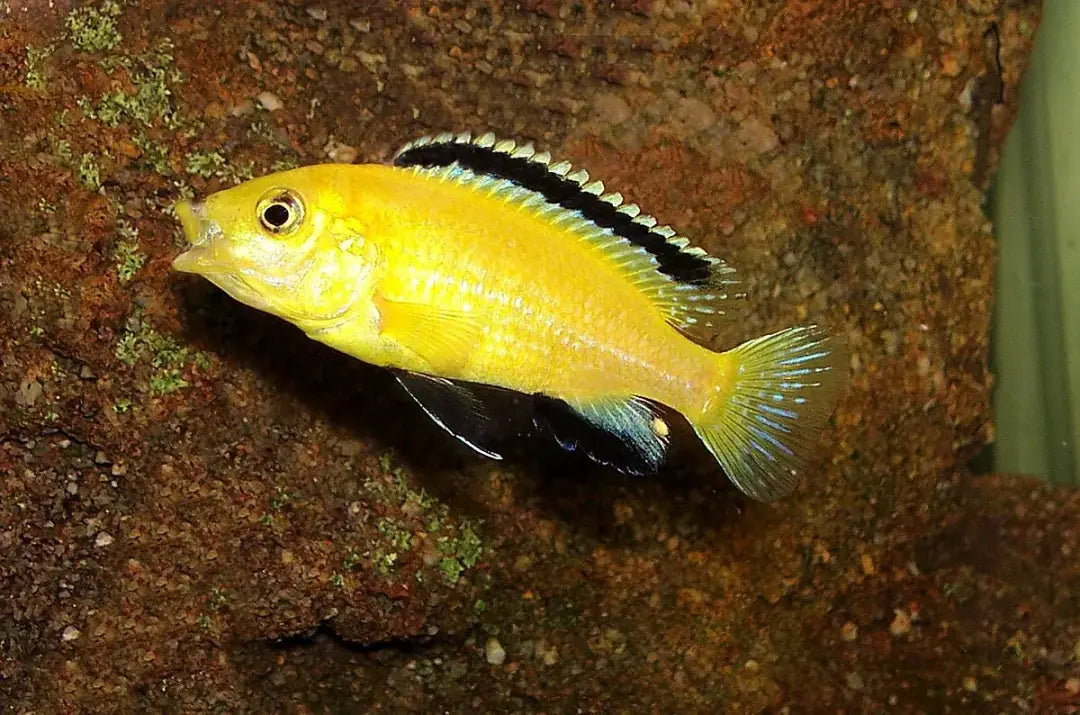Yellow Labidochromis (Labidochromis caeruleus) - Live Fish
Yellow Labidochromis (Labidochromis caeruleus) - Live Fish
Total items
Product subtotal
Detailed Description
Detailed Description
The Yellow Labidochromis Cichlid (Labidochromis caeruleus), commonly known as the Yellow Lab, is a popular species among aquarium enthusiasts due to its vibrant color, peaceful nature, and relatively easy care requirements. It is a member of the Labidochromis genus and is native to Lake Malawi in East Africa. This cichlid is especially loved for its bright yellow coloration and calm demeanor, making it a great addition to many African cichlid community tanks.
Physical Characteristics:
-
Coloration:
- The most defining feature of the Yellow Lab is its bright yellow body. Males tend to have a more vivid yellow coloration, while females are usually a little more muted in color.
- The face and fins can sometimes have a slight blue or black hue, especially in males during breeding times.
- They have a slender, elongated body with long dorsal fins and a forked tail.
-
Size:
- Adult Yellow Labs grow to about 4 to 5 inches (10 to 13 cm) in length, making them a manageable size for most aquariums.
Care Requirements:
-
Water Conditions:
- The Yellow Labidochromis thrives in slightly alkaline water with a pH between 7.5 and 8.5.
- The ideal temperature range is between 75°F and 82°F (24°C to 28°C), which replicates the conditions of Lake Malawi.
- They prefer hard water, typical of their native environment, so it’s important to monitor and maintain these conditions for their health.
-
Tank Setup:
- A 55-gallon tank or larger is recommended for a small group of Yellow Labs. Larger tanks are preferred for keeping multiple fish, as they need space to swim and establish territories.
- The tank should be decorated with rock formations, caves, and sand or fine gravel substrate to mimic the rocky shores of Lake Malawi.
- As Yellow Labs are relatively peaceful, a well-planted tank with plenty of hiding spots can help reduce stress and territorial behavior.
Diet:
- Yellow Labidochromis Cichlids are omnivores, meaning they eat both plant matter and protein.
- Their diet can include cichlid pellets, spirulina, algae wafers, and live or frozen foods like brine shrimp, bloodworms, or daphnia.
- It’s important to feed them a balanced diet that enhances their color and promotes overall health.
Behavior and Socialization:
-
Temperament:
- The Yellow Lab is known for being relatively peaceful compared to many other African cichlids. While they can show some territorial behavior, they are generally more docile and can coexist well with other similarly peaceful fish.
- Males may become territorial, especially during breeding times, but they are less aggressive than many other cichlids.
-
Compatibility:
- Yellow Labs can be kept with other peaceful African cichlids from Lake Malawi that share similar water parameters, such as Pseudotropheus, Cynotilapia, and Metriaclima species.
- They may also coexist with other larger community fish that are not aggressive. Avoid keeping them with overly aggressive or highly territorial species that could stress them out.
Breeding:
- The Yellow Lab is a mouthbrooder, meaning that the female holds the fertilized eggs in her mouth until they hatch.
- Males display their bright yellow coloration and perform nuptial displays to attract females. They may show off their fins and swim around the female in an effort to impress her.
- After fertilization, the female holds the eggs in her mouth for about 3 weeks until the fry are ready to swim independently.
The Yellow Labidochromis Cichlid is a great choice for both beginner and experienced aquarium hobbyists. It offers vibrant color, peaceful behavior, and relatively straightforward care requirements. With its striking yellow body and calm temperament, the Yellow Lab can add beauty and personality to a well-maintained aquarium, making it an excellent addition to a community tank.
Product features
Product features
Materials and care
Materials and care
Merchandising tips
Merchandising tips
Share












